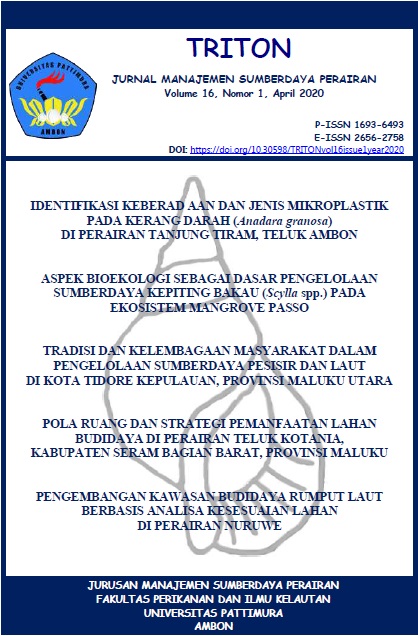IDENTIFIKASI KEBERADAAN DAN JENIS MIKROPLASTIK PADA KERANG DARAH (Anadara granosa) DI PERAIRAN TANJUNG TIRAM, TELUK AMBON
Abstract
The existence of inorganic waste in the form of plastic is perilous for marine life. Plastics can be broken into micro size known as microplastics. Microplastic is harmful to marine biota because it can be consumed and entered the digestive tract. The purpose of this study was to identify the presence and types of microplastics in cockles blood clams (Anadara granosa) in Tanjung Tiram, Ambon Bay waters. The research method used field observations and laboratory analysis. The results showed that in cockles, fiber was found as much as 360 particles and 61 particles of fragments. The presence of microplastics that have been consumed by cockle will be harmful marine biota as well as humans who consume the cockles. Plastics that contain harmful chemicals will be absorbed into the body of cockles. Based on the results of the study, it can be concluded that microplastics have been found and consumed by cockles.
ABSTRAK
Keberadaan sampah anorganik berupa plastik sangat membahayakan bagi kehidupan perairan. Plastik dapat terpecah menjadi ukuran mikro yang dikenal dengan mikroplastik. Keberadaan mikroplastik sangat berbahaya bagi biota perairan karena dapat dikonsumsi dan masuk ke saluran pencernaan. Tujuan dari penelitian ini yaitu
mengidentifikasi keberadaan dan jenis mikroplastik pada kerang darah (Anadara granosa) di Tanjung Tiram perairan Teluk Ambon. Metode penelitian menggunakan observasi lapangan kemudian analisa laboratorium. Hasil penelitian menunjukkan bahwa pada kerang darah, telah ditemukan mikroplastik dengan jenis fiber sebanyak 360 pratikel dan fragmen sebanyak 61 pratikel. Keberadaan mikroplastik yang telah dikonsumsi oleh kerang darah akan berbahaya bukan hanya bagi biota perairan namun juga bagi manusia yang mengkonsumsi kerang darah tersebut. Plastik yang mengandung bahan kimia berbahaya akan terserap masuk ke dalam tubuh kerang darah. Berdasarkan hasil penelitian dapat disimpulkan bahwa mikroplastik telah berada dan dikonsumsi oleh kerang darah.
Kata Kunci: mikroplastik, kerang darah, fiber, fragmen, Tanjung Tiram
Downloads
References
Andrady, A. L. 2011. Microplastics in the marine environment. Marine Pollution Bulletin, 62 (2011), 1596–1605. https://doi.org/ 10.1016/j.marpolbul.2011.05.030
Ayuningtyas, W. C., D. Yona, S. H. Julinda, F. Iranawati. 2019. Kelimpahan Mikroplastik Pada Perairan di Banyuurip, Gresik, Jawa Timur. Journal Fisheries and Marine Research 3(1): 41-45.
Boerger, C. M., Lattin, G. L., Moore, S. L., & Moore, C. J. (2010). Plastic Ingestion by Planktivorous Fishes in THE NORTH PACIFIC Central Gyre. Marine Pollution Bulletin, 60(12), 2275–2278. https://doi.org/10.1016/j.marpolbul.2010.08.007.
Browne, M.A., Dissanayake, A., Galloway, T.S., Lowe, D.M., Thompson, R.C., 2008. Ingested Microscopic Plastic Translocates to The Circulatory System of The Mussel, Mytilus edulis (L.). Environmental Science and Technology. 42, 5026e5031.
Darmono, 2001. Lingkungan Hidup dan Pencemaran (Hubungannya dengan Toksikologi Senyawa Logam), Penerbit: Universitas Indonesia Press, Jakarta
Fitri, A. 2017. Studi Awal Mikroplastik Pada Kerang Darah (Anadara granosa) dari Tambak Lorok Semarang. Tesis. Universitas Katolik Soegijapranata.
Garcia, B., M. M. Fang, J. Lin. 2019. Marine Plastic Pollution in Asia: All Hands on Deck!. Chinese Journal of Environmental Law 3(1): 11-46. DOI: https://doi.org/10.1163/ 24686042-12340034.
Griet, V., V.C.Lisbeth., J.Colin R., M.Antonio., G.Kit., F.Gabriella., K.Michiel. D.Jorge.,B.Karen., R.Johan., D. Lisa. (2015). A Critical View on Microplastics Quantification in Aquatic Organisms. Eviromental Research, 143: 46 -55.
Hidalgo, V., L. Gutow, R. C. Thompson, M. Thiel. 2012. Microplastics in The Environment: A Review of The Methods Used for Identification and Quantification. Environmental Science and Technology 46(6):3600-3075.
Kamsiati, E., H. Herawati, E. Y. Purwani. 2017. Potensi Pengembangan Plastik Biodegradable Berbasis Pati Sagu dan Ubi Kayu di Indonesia. Jurnal Litbang Pertanian 36(2): 67-76. DOI: 10.21082/jp3.v36n2.2017.p67-76.
Li J., D. Yang, Lan Li, K. Jabeen, H. Shi. Microplastic in Commercial Bivalves form China. 2015. Environmental Pollution 207(2015):190-195.
Lusher, A., Hollman, P., & Mandoza-Hill, J. J. (2017). Microplastics in fisheries and aquaculture. In FAO Fisheries and Aquaculture Technical Paper. https://doi.org/dmd.105.006999[pii]r10.1124/dmd.105.006999.
Manullang, C. Y. 2019. The Abudance of Plastic Marine Debris on Beaches in Ambon Bay. IOP Conference Series: Earth and Environmental Science 253 (2019) 012037. doi:10.1088/1755-1315/253/1/012037.
Plastics, E. 2019. Plastics-The Facts 2019 An Analysis of European Plastics Production, Demand and Waste Data. https://www.plasticseurope.org/application/files/1115/7236/4388/ FINAL_web_version_Plastics_the_facts2019_14102019.pdf.
Putri, G. R. Karakteristik Bioplastik dari Rumput Laut (Euchema cottonii) dan Pati Singkong Dengan Penambahan Pati Biji Alpukat. 2019. Risenologi (Jurnal Sains, Teknologi, Sosial, Pendidikan, dan Bahasa) 4(2): 59-64. p-ISSN : 2502-5643.
Safitri, I., M. Riza, Syaubari. 2016. Uji Mekanik Plastik Biodegradable dari Pati Sagu dan Grafting Poly (Nipam)-Kitosan dengan Penambahan Minyak Kayu Manis (Cinnamomum burmannii) sebagai Antioksidan. Jurnal Litbang Industri 6(2): 107-116. E-ISSn: 2502-5007.
Steibl, S & Laforsch, C. 2019. Disentangling the Environmental Impact of Different Human Disturbances: A Case Study on Islands. Sci Rep 9, 13712 (2019). https://doi.org/10.1038 /s41598-019-49555-6.
Rochman, C.M., Kurobe T, Flores I, Teh S.J. (2015). Early Warning Signs of Endocrine Disruption in Adult Fish From The Ingestion of Polyethylene With and Without Sorbed Chemical Pollutants From The Marine Environment. Science of The Total Environment 493 656-661. http://dx.doi.org/10.1016/j.scitotenv.2014.06.051.
Teuten E. L, Saquing J. M., Knappe D. R. U., Barlaz M. A., Jonsson S., Bjorn A., Rowland S. J, Thompson R. C., Galloway T. S., and Yamashita R. 2009. Transport and Release of Chemicals from Plastics to The Environment and to Wildlife. Philosophical Transactions of the Royal Society B. 364: 2027-2045. doi:10.1098/rstb.2008.0284.
Tuhumury, N., & Kaliky, I. 2019. Identifikasi Sampah Pesisir di Desa Rumah Tiga Kota Ambon. TRITON: Jurnal Manajemen Sumberdaya Perairan, 15(1), 30-39. https://doi.org/10.30598/TRITONvol15issue1page30-39.
Widianarko, B & I. Hantoro. 2018. Mikroplastik dalam Seafood dari Pantai Utara Jawa. Penerbit Universitas Katolik Soegijapranata. ISBN 978-602-6865-74-8.
Wright, S. L., Thompson, R. C., & Galloway, T. S. (2013). The Physical Impacts of Microplastics on Marine Organisms: A Review. Environmental Pollution, 178, 483– 492. https://doi.org/10.1016/j.envpol.2013.02.031
Zhang W, Zhang S, Wang J, Wang Y, Mu J, Wang P, Lin X, Ma D. 2017. Microplastic Pollution in The Surface Waters of the Bohai Sea, China. Environ Pollut 231: 541-548.


1.png)










